- Site Author and Publisher Richard Jones
- Richard Jones
THE WORKING LADS INSTITUTE
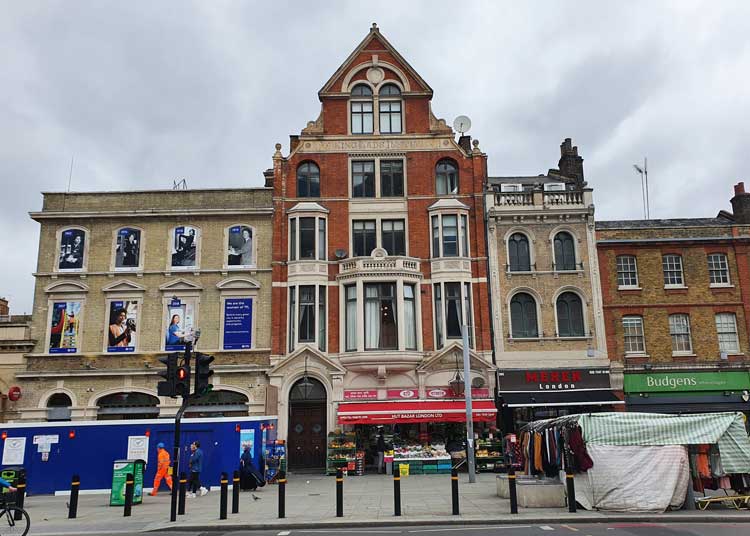
| Location: 283, Whitechapel Road, London, E1. |
WHERE SEVERAL INQUESTS WERE HELD
On Whitechapel Road, a little way past what used to be the entrance to Whitechapel Underground Station, you will find a soaring red-brick building, that towers over the premises on either side of it. The building's upper stories have now been converted into flats, whilst a shop is located on its ground floor.
Few passers-by ever bother to give the building a second's glance and continue on their way oblivious to its existence. Those who do bother to look up at it might notice the words "Working Lads Institute" emblazoned across its upper level, albeit the lettering is now somewhat weatherworn, and gets more difficult to decipher with every year that passes.
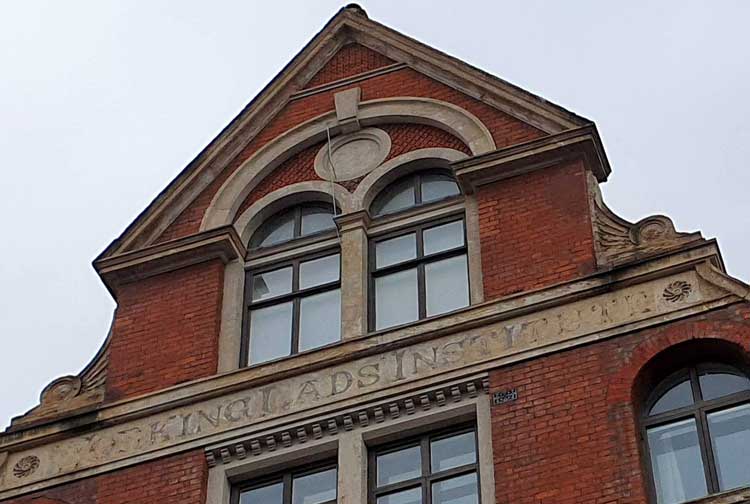
SWIMMING BATH, GYMNASIUM AND LECTURE HALL
On closer inspection, they might spot the words "Gymnasium And Swimming Bath" and "Lecture Hall" carved into the stone behind the black lamps that protrude from the pediments above its left and right doorways; but even these might be perceived as some bygone curiosity, and be afforded but a cursory glance.
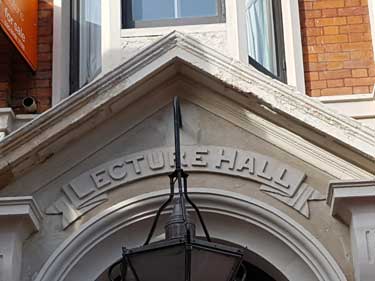
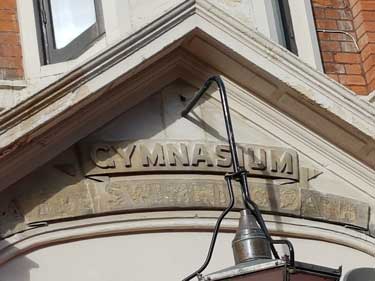
THE JACK THE RIPPER CONNECTION
What few people walking past the building give any thought to, however, is that this splendid building actually has a direct connection to the Whitechapel murders.
For it was here that the inquests into the deaths of Martha Tabram, Mary Nichols, Annie Chapman, Alice McKenzie, and Frances Coles were held.
An idea of the layout of the Library, in which the inquests took place, can be gleaned from the following article, which appeared in The East London Observer on Saturday, 11th August, 1888:-
The interest evinced in the case was proved by the unprecedentedly large umber of summoned jurymen who put in an appearance - twenty of them in all - who appointed a Mr. Geary as their foreman.
They sat to the left of the coroner, who had on his right Dr. Killeen and Inspector Reid - a smart looking man, dressed in blue serge, who, without taking so much as a note, seemed to be absorbing all the material points.
Above the coroner hung a magnificent portrait by Heir Louis Fleischman, of the Princess of Wales, while other portraits of the Royal Family and landscape pictures were in profusion around the walls of the room.
It was in this library, so well and prettily furnished, that the details of the Whitechapel mystery were unravelled..."
Source: East London Observer, Saturday, 11th August, 1888.
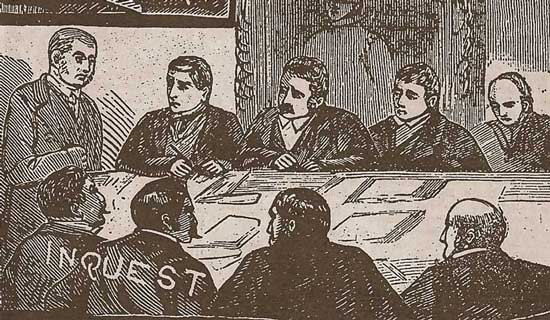
A CHANGE IN THE TYPE OF VENUE
Since there was, at the time, no specific Coroner's Court in the district, it was customary to hold an inquest at a public building - more often than not a public house - close to the scene of death.
However, the district Coroner, Wynne Edwin Baxter, shortly before the commencement of the Whitechapel murders, took the decision to make use of venues that he felt were better suited for the seriousness of the proceedings.
The East London Advertiser, thought he had made a wise decision, and commended him for it in its edition of Saturday, 15th September, 1888:-
A word may be said as to the great advantage there is in selecting such a place as the Lads Institute for coroner's inquiries.
The hall is lofty and light, while there is plenty of room for everyone.
The improvement upon the custom of hiring a public house room is manifest, and the new departure inaugurated by Mr. Wynne Baxter cannot be regretted..."
The East London Advertiser, Saturday, 15th September, 1888.
A GLIMPSE OF THE PROCEEDINGS
The newspaper also provided an intriguing glimpse of the lead-up to the inquest into Annie Chapman's death:-
There was considerable uncertainty as to the time fixed for holding the inquest, and this doubtless accounted for the absence of any demonstration outside the Working Lads' Institute in the Whitechapel-road, where it was well known the inquest would take place. The two previous inquests had been held here and the place has, therefore, acquired a certain kind of notoriety.
Half-past-nine was rumoured as the hour for the proceedings to begin, but ten o'clock was entered upon the jurors summonses.
Shortly after nine o'clock some police constables arrived, together with a few pressmen, and these appearances upon the scene considerably interfered with the labours of a few industrious charwomen who were sweeping out the hall.
Up till half-past-nine the only arrivals were the reporters; but soon the jurymen began to drop in by twos and threes, and took their seats at the back of the hall to wait until when they were called upon to discharge their judicial duties..."
Some of the witnesses by this time arrived, and they all presented a very different appearance to what they did in the mortuary yard on Saturday morning, when they identified the body of the poor unfortunate woman, for the information of the police. They were now clean and as neatly dressed as their positions in life and means enabled them.
By this time the news that the inquest was being held got wind, and the idlers in Montague and Hanbury-streets made a move to the main thoroughfare.
None of them dared to venture past the guardians of law and order, who were stationed at the end of the stone passage leading into the building, but they stood staring stolidly up at the pretty edifice which was opened by their Royal Highnesses the Prince and Princess of Wales some two years ago.
The "Move on, please" from the constables on duty in the road was continually heard, and their well-timed exertion prevented any congestion of the pavement traffic.
Mr. Banks, the coroner's officer, at length arrived with his ubiquitous black bag, and Mr. George Collier, the deputy coroner, quickly followed him. First of all it was thought that Mr. Collier was going to conduct the inquiry, but Mr. Wynne Baxter's entrance soon dispelled that idea.
In a quick business-like way the preliminaries were soon got through, the jurymen were seated in their usual places in the right hand corner of the room and the police officials on the other side facing them..."
The East London Advertiser, Saturday, 15th September, 1888.
THE ORIGINS OF THE WORKING LADS INSTITUTE
However, the Institute itself was a philanthropic endeavour, the origins of which were inspired, in part, by a desire to discourage the youth of London from becoming just the sort of "idlers" referred to in the Advertiser's article.
When the idea for such an institution was conceived in the mid 1870s, the intention was to have Working Lads Institutes all over London in order to give young working lads over the age of thirteen somewhere at which to keep their minds and bodies occupied, and thus keep them away from the corrupting influences of the cheap theatres, music halls and penny gaffs that were prevalent and popular on the streets of Victorian London.
The driving force behind the Working Lads Institute was Mr. Henry Hill, and The Pall Mall Gazette, on Saturday, 31st October, 1885, provided details of how he was inspired to found his charitable endeavour:-
One day towards the latter part of 1875 a lad, with a large parcel of quill pens upon his head, might have been seen slowly trudging his way through busy Cheapside, eagerly devouring, utterly regardless of the currents of humanity which swept swiftly along on either side of him, the latest issue of a “penny dreadful” for boys.
A servant of the firm by whom the boy was employed having accidentally met him thus, his conduct was reported to his master, Mr. Henry Hill.
Mr. Hill, having had the lad brought before him, elicited that the boy went to neither night school nor Sunday school, and read no other literature than the sensational stories which unfortunately find so large a circulation among the working boys of our land.
"Here," was Mr. Hill's reflection, "is a lad who is a complete a heathen;" and he was led to think seriously of the lot and fortunes of the working lads of London.
A single walk down the main thoroughfares of the East-end was sufficient to convince him as to the pressing necessity for action in the direction of the provision of facilities for the greater enjoyment and more profitable employment of the leisure hours of "our boys."
The groups at the corners of the alleys and streets, the crowds of boys in the low theatres and "penny gaffs" - all told a grievous tale; one friend of the movement who about this time visited a low theatre in Whitechapel counted over four hundred lads, of ages varying from thirteen to eighteen years.
Mr. Hill, once impressed with the importance of the subject, not merely to the lads, but to society at large, did not permit either himself or his friends to go to sleep; and an article, "The Lads of London," published in The Christian of December 16, 1875, led up to a meeting at the Mansion House in October, 1876, at which this particular movement for the amelioration of the lot of the working lads of London was fairly set on its feet.
The Working Lads Institute was commenced in a very humble way in a house and shop at the Mount, Whitechapel; and, falsifying the fears of friends, within three years the premises proved far too small for the work in hand.
Source: The Pall Mall Gazette, Saturday, 31st October, 1885.
THE FIRST INSTITUTE
The first such institute was located on the opposite side of Whitechapel Road to where the current building now stands, and was set up in 1876, and catered for an initial 20 boys.
However, within two years, it was being reported that over 500 boys had "come within its influence" and had been "rescued from the influences of the public houses, music halls and theatres."
In May 1880, the London Daily News enlightened its readers as to some of the temptations that were liable to cause the youth of the age to stray from the righteous path:-
The method in which the great majority spend their evenings may be studied with great advantage in Whitechapel.
So long as anything remains out of their last week's wages, they saunter about the great eastern boulevard, and indulge in the refreshments which, ranging from sausages and mutton pies to almond rock and peppermint drops, are arranged in the shop windows in as tempting fashion as their nature will permit.
The boulevard is also largely frequented by girls of similar age to that of the lads, and when these young people are in funds they adjourn to the shows or "gaffs" common in the far East of London.
That a youth passed in "loafing" of this kind should produce abundant specimens of that most pestilent of creatures, the young or hobbledehoy "rough," is not to be wondered at, and it was to prevent lads capable of better things from falling into that category that the Working Lads' Institute was founded."
London Daily News, Thursday, 6th May 1880.
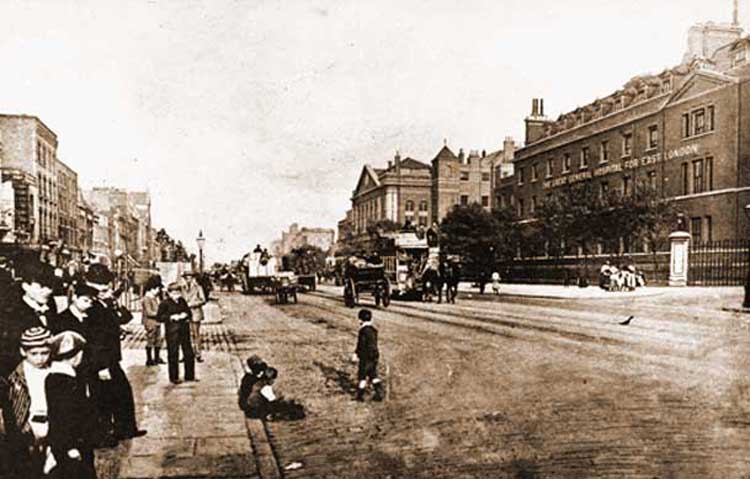
A NEW HEADQUARTERS NEEDED
By the early 1880s, thousands of boys had passed through its doors, and it was becoming more than apparent that, so popular had the Institute become, that the house it then occupied was insufficient for the demand, and a purpose built premises was required.
To that end, in 1883, a movement was launched to raise funds for the erection of a new home for the Working Lads Institute:-
A meeting took place yesterday afternoon at the Mansion House to provide funds for an institute for working lads in the East of London.
The object of the association is to promote the welfare of the working lads of the metropolis. This it seeks by establishing, in those neighbourhoods where large numbers are employed or reside, institutes where such youths may profitably spend the evening hours, and so be saved from the temptations and snares of the streets, the public-houses, music halls, and low theatres.
In connection with each institute will be provided healthy recreation, good and useful reading, and the means of educational and moral improvement."
Source: London Evening Standard, Saturday, 13th October, 1883.
A PLOT PURCHASED
A year later, The East London Observer, was able to report that the site of the current building had been acquired, and the battle was now on to raise sufficient funds to build the premises:-
...it has been determined to provide a new Working Lads Institute for East London.
A plot of freehold land has been secured in Whitechapel, opposite the London Hospital, and adjoining the East London Railway Station, Whitechapel-road. The contractor for the new building is Mr. B. E. Nightingale, and the architect, Mr. G. Baines.
The new institute will provide the means of mental and moral improvement and healthy recreation for about 1,000 members, the accommodation afforded including a refreshment-room, a gymnasium, a reading-room with students room and library, five class-rooms, mechanical workshop, school of art, dormitories for forty members, swimming and private baths, and a lecture hall, with gallery to seat 660 persons.
Not only are the wealthy and benevolent in town and country appealed to for aid in this work, bat also business men and employers, as the direct influence of the institute is to make the lads intelligent, honest, and trustworthy.
The dormitories are specially provided for lads coming from the country, and those without a home."
Source: The East London Observer, Saturday, 18th October, 1884.
A HANDSOME AND SUBSTANTIAL BUILDING
Despite considerable objection from the District Railway, the officers of which wanted to obtain the land for their own use, the foundation stone for the new building was laid by the Lord Mayor of the City of London on Wednesday, 15th October, 1884, and, over the next 12 months, the new building, which on completion would be the tallest building in Whitechapel at the time, was erected.
On its completion, The London Daily News was one of many newspapers to wax lyrical about how aesthetically pleasing the building was:-
The new building stands adjacent to the Whitechapel station of the East London line, and partly over the railway.
Mr. George Baines, is the architect, and he has good reason to be proud of a building as bright, comfortable, and well-arranged within as without; it is a handsome and substantial without being unsuitably elaborate and showy. It is built of red brick, with stone dressings, and the front consists of a ground floor and four stories above."
Source: The London Daily News, Monday, 2nd November, 1885.
THE NEW BUILDING OPENS
The new Working Lads Institute building was opened on Saturday the 31st of October, 1885 by the Princess of Wales, who was accompanied by her husband, the Prince of Wales, and their eldest son, Prince Albert Victor, Duke of Clarence.
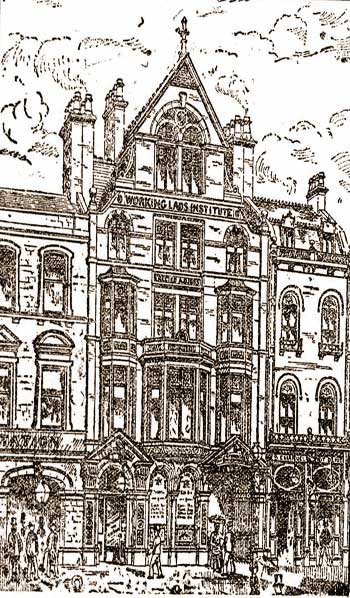
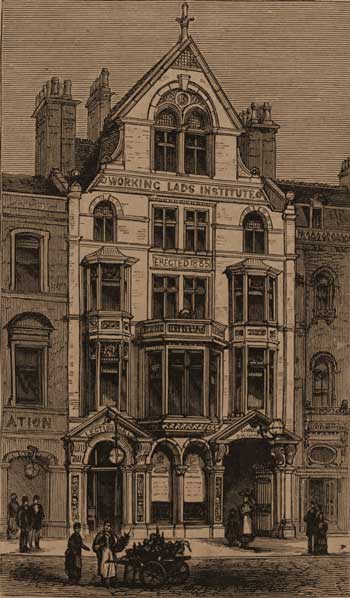
THE OPENING CEREMONY
The Illustrated London News gave a detailed account of the opening ceremony in its edition of Saturday, 7th November, 1885:-
The Princess of Wales, who was accompanied by the Prince of Wales and their eldest son and daughter, paid a visit on Saturday afternoon to the east end of London, where the Princess opened the new Working Lads' Institute, which has been erected in the Whitechapel-road, nearly opposite the London Hospital.
The entire length of that road, from the comer of the Commercial-road, was gay with flags and mottoes of welcome, and despite the rain which continued throughout the day, there was an immense assemblage of people along the roadway through which the Royal party had to pass.
The Institute, which has a bold front elevation of four floors, is of red brick, with Portland and Ancaster stone dressings, a prominent feature being a three-sided oriel window, with bay windows on either side upon the first floor.
The interior arrangements include reading and conference rooms, gymnasium, class-rooms, laundry, mechanical work-rooms, dormitories, and kitchen.
Only twenty-four beds are ready at present, but there is room for sixty when the necessary funds are obtained.
The Royal party arrived at the Institute at four o'clock, and were received by the Lord Mayor and Lady Mayoress, Mr. Alderman and Sheriff Evans, Mr. F. H. Bevan (treasurer), Mr. Hill, Sir James Tyler, Dr. Tyler, and others, with a guard of honour with the band of the Tower Hamlets Rifle Brigade, under Colonel Mapleson.
Their Royal Highnesses, who were attended by Lord Colville of Culross, Colonel A. Ellis, and Miss Knollys, were conducted to a prettily decorated canvas pavilion in the rear of the building, which was well filled.
A bouquet was presented to the Princess of Wales by Mrs. Hill on behalf the boys of the Institute, and the proceedings having been opened with a prayer, Mr. Hill, the honorary secretary, described the purposes of the Institute, which was the development of a very small beginning nine years ago. The effort then made to attract young working lads from the streets, and the evils of low music-halls, theatres, and penny gaffs, had been eminently successful; much so, that in the period referred to 1620 lads had taken advantage of the old Institute.
After detailing the difficulties they had experienced in procuring a suitable site when the removal and enlargement became imperative, said the estimated cost of the whole Institute, which would accommodate over thousand boys, was £12,000, of which one half was still required. The amount they had received had been expended in erecting the building about to be opened, but to that they intended to add, upon the ground occupied by the pavilion, the second portion, which would include a swimming-bath and lecture hall.
The Princess of Wales then, amidst the cheers of the company, declared the new building opened and devoted for ever to the welfare of the working lads of London.
The Prince of Wales briefly addressed the meeting, and expressed his interest in the objects of the institution.
The Princess graciously acceded to the reading-room being named the "Alexandra Room."
As their Royal Highnesses left the building they received another great demonstration of goodwill from the crowd."
Source: The Illustrated London News , Saturday, 7th November, 1885.
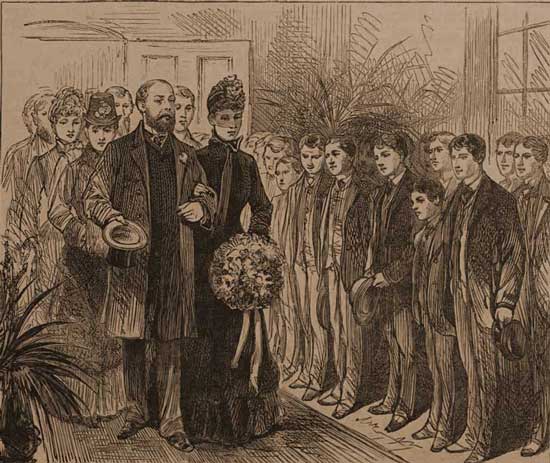
A PLACE OF HEALTHY RECREATION
That the work of the Institute was valuable and needed was the topic of the following article, which appeared in The Graphic on the Saturday after the building had been opened:-
Thousands of lads, many of them from the country, are employed daily in London warehouses and shops as errand boys, apprentices, factory hands, etc. Most of them work hard from 8 A.M. till about 7 P.M., but thenceforward until bedtime their time is their own.
It is during these hours of leisure that youths are especially liable to temptation, and, without endorsing all the prejudices of serious-minded people against theatres and music halls, it must be admitted, even by men of the world, that there are numerous places of amusement where lads are likely to learn harm rather than good.
To give them, therefore, a place of healthy recreation the Working Lads' Institute was established about eight years ago in Whitechapel, and the concern has thriven so greatly that a larger and far more commodious building has lately been erected opposite the London Hospital, and adjoining the East London Railway Station.
The new building contains rooms for classes, for mechanical employments, and for refreshments: besides which there is a lecture hall, a gymnasium, and a swimming bath.";
Source: The Graphic, Saturday, 7th November, 1885.
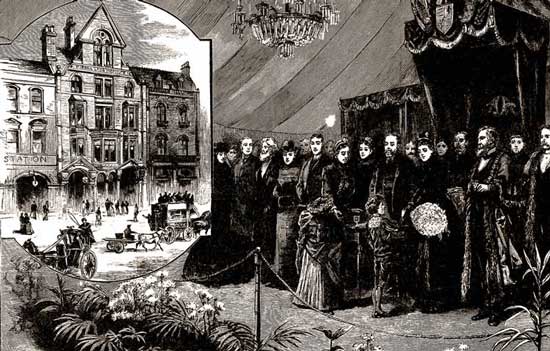
AN INFLUENCE FOR GOOD IN WHITECHAPEL
The Pall Mall Gazette was another newspaper that was fulsome in its praise of the Institute:-
From several points of view it might be forcibly shown that no more important work can be undertaken than that which Mr. Hill and his friends have in hand.
This bright, cheery Institute, we are bound to believe, will be as a great an influence for good in dreary Whitechapel; and the end thereof we may not know."
Source: The Pall Mall Gazette, Saturday, 31st October, 1885.
ITS LATER YEARS
Over the next two decades, as well as being used as a venue for various inquests, the Working Lads Institute continued to cater for the well-being of the youth of Victorian London.
Towards the end of the 19th century, the Whitechapel Primitive Methodist Mission moved into the premises, and, under the auspices of the Reverend Thomas Jackson, promoted itself as "a home for friendless and orphan lads."
The mission moved elsewhere in 1906, whereupon the building became a hostel for young men aged seventeen to twenty-one.
This closed in 1971, and the building was sold.
In 1997 the upper floors, including the room where the inquests into the deaths of several of the Whitechapel murders victims were held, were converted into the flats that now occupy what is still a splendid building on Whitechapel Road.
